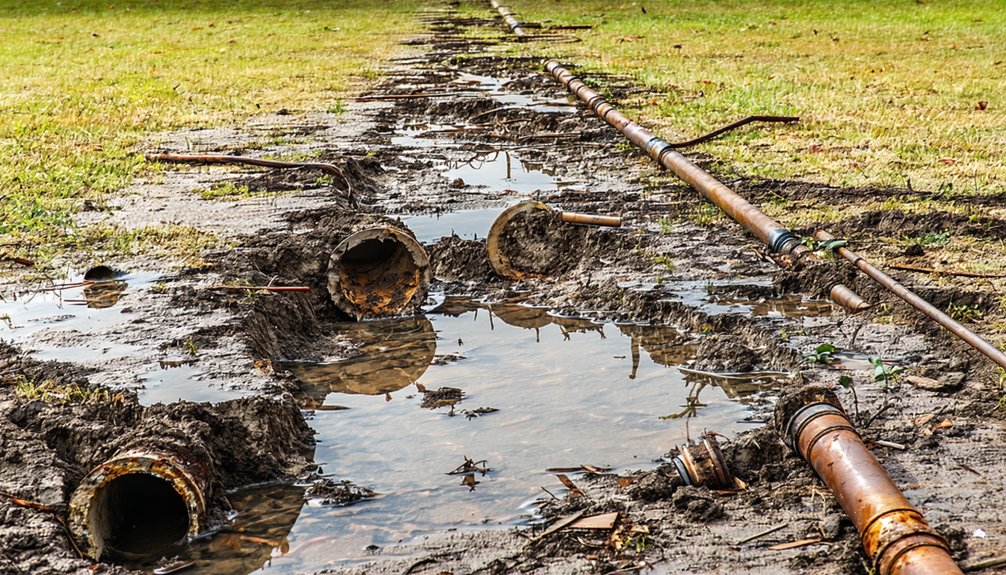The three best signs of sewer line failure include foul odors, gurgling toilets, and slow drains. Foul odors can indicate potential sewer line failure and health risks. Gurgling toilets may signify trapped air due to blockages, hinting at deeper plumbing issues. Slow drains are alarming as they often point to blockages in the main sewer line. Addressing these symptoms promptly is essential for maintaining plumbing integrity. Further insights can provide valuable preventive measures and solutions for these problems.
Foul Odors
Foul odors serve as a critical indicator of potential sewer line failure. These unpleasant smells, often characterized as sewer gas, can signal serious plumbing issues, including leaks or backups in the drainage system. Homeowners should not dismiss unexplained foul smells, as they often point to significant sewer line issues that require immediate attention. The emergence of strong sewer odors may indicate dried-out drains, which compromise the drainage, waste, and vent (DWV) system, facilitating the growth of mold and mildew. Additionally, prolonged exposure to sewer gas can pose health hazards, necessitating swift action to mitigate risks. Regular monitoring for these odors is essential; early detection can prevent costly repairs and significant damage to the property. Addressing foul odors promptly not only safeguards physical structures but also promotes a healthier living environment, liberating residents from the adverse effects of neglecting underlying sewer line problems.
Gurgling Toilets
Gurgling toilets frequently indicate underlying issues within the plumbing system, specifically the presence of trapped air in the sewer line. This phenomenon often arises when air is forced back up the pipes due to an obstruction, such as a clogged drain or a break in the main sewer line. Gurgling is not a normal function of a toilet and signals potential plumbing issues that necessitate prompt professional evaluation. Ignoring these sounds can lead to severe consequences, including sewer backups and extensive damage to the plumbing system. In homes with older plumbing systems, tree root intrusion can exacerbate gurgling noises, further indicating the need for immediate inspection and repairs. Addressing these concerns early can prevent more significant issues, ensuring the integrity of the sewer line and the overall functionality of the plumbing system.
Slow Drains
Slow drains can serve as an alarming indicator of deeper issues within a plumbing system, particularly when they occur in multiple fixtures throughout a home. Such persistent slow drainage often signifies blockages within the main sewer line, warranting immediate professional inspection. Common culprits include tree root intrusion, grease buildup, or debris accumulation, all of which can lead to severe plumbing problems if left unaddressed. This condition should not be dismissed, as it serves as an early warning sign of potential sewer line breaks or collapses. Homeowners are urged to monitor slow drains closely; failure to act may result in costly repairs due to sewage backup or extensive damage to the plumbing system. Timely assessment and specialized cleaning methods, such as hydro jetting, may be necessary to restore proper function and mitigate risks associated with deteriorating sewer infrastructure. Additionally, scheduling annual inspections can help identify potential issues before they escalate into major problems.
Frequently Asked Questions
How Do You Know if Your Sewer Line Is Bad?
A staggering 78% of homeowners experience sewer line issues at some point. Warning signs include persistent slow drains and gurgling sounds, indicating potential blockages. Smell detection of unpleasant odors and water pooling in the yard suggest leaks or pipe corrosion, often exacerbated by tree roots invading the lines. Regular maintenance tips, such as inspection and timely repairs, are essential for preventing severe plumbing issues and ensuring the longevity of the sewer system.
Is Sewer Line Damage Covered by Homeowners Insurance?
Determining if sewer line damage is covered by homeowners insurance requires examining policy specifics. Coverage limits and common exclusions may vary, affecting repair costs for different damage types. Homeowners are often responsible for sewer lateral issues, while municipalities handle main lines. Filing claims necessitates prompt reporting and adherence to guidelines. Preventative measures may influence coverage, as insurers often adjust policies based on perceived negligence. Consulting with providers guarantees clarity on coverage and potential endorsements for enhanced protection.
How Do You Know if You Need to Replace a Sewer Line?
Determining the need for sewer line replacement involves examining several critical signs. Frequent slow drains, backed up toilets, and foul odors may indicate severe plumbing issues. Water pooling in unusual areas can signal leaks, while structural damage might suggest deeper problems. Additionally, root intrusion could compromise the line's integrity. Conducting thorough plumbing inspections, including video inspection, helps identify these replacement signs, ensuring timely intervention and preventing further complications.
How Much Does It Cost for a Plumber to Unclog a Sewer Line?
The cost for a plumber to unclog a sewer line varies considerably, influenced by factors such as plumber rates, the severity of the clog, and the necessity for sewer inspection. Basic clog removal may range from $150 to $500, while emergency services can exceed $1,000. Additional expenses may arise from drain cleaning or pipe replacement, with local plumbers sometimes offering flat rates. Homeowners may also consider DIY methods for routine plumbing maintenance to mitigate costs.



